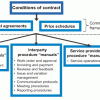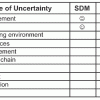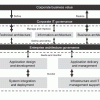Business Transformation Requires Transformational Leaders
Leadership and teaming skills are front and center in times of rapid change. Meet today’s constant disruption head on with expert guidance in leadership, business strategy, transformation, and innovation. Whether the disruption du jour is a digitally-driven upending of traditional business models, the pandemic-driven end to business as usual, or the change-driven challenge of staffing that meets your transformation plans—you’ll be prepared with cutting edge techniques and expert knowledge that enable strategic leadership.
Recently Published
The service-level agreement (SLA) is a critical element in the suite of contractual and governing documents that surround any outsourcing engagement. This Executive Report provides an overview of SLAs including their purpose and key elements. It then discusses the necessary preparations as you make the decision to create an SLA, before detailing the seven sections of this document. The report concludes with suggestions for drafting an SLA.
Service Orientation: The Cultural Dimension
Business is increasingly moving toward a marketplace model, which is in sharp contrast to the traditional view of an organization as a production line. In this new world, organizations collaborate together, consuming and offering services to maximize efficiency, better serve customers, and achieve long-term advantage. This is the world of service orientation in which simply automating business activities in software is no longer sufficient; software must be agile enough to cope with change and foster innovation.
Service-Level Agreements: Articulating What Will Make a Successful Deal
That most outsourcing deals have a contract is a well-known fact, and the purpose of contracts, as many people will tell you, is to protect the parties in the event of litigation. However, if contracts are useful documents designed to help you in court, then there is one type of document helpful in keeping your outsourcing deal out of court to begin with -- the service-level agreement (SLA).
Service Orientation: The Cultural Dimension
Business is increasingly moving toward a marketplace model. This model is in sharp contrast to the traditional view of an organization as a production line. In this new world, organizations collaborate together, consuming and offering services to maximize efficiency, better serve customers, and achieve long-term advantage. This is the world of service orientation, in which business is increasingly less supported by software and more enabled by it.
In today's economic climate, sourcing initiatives are mostly established and managed as relationship-driven engagements. Whether all parties involved in sourcing engagements (sourcing providers, clients, and associated third-party vendors) are equally vibrant in growing the partnership or not, sourcing companies make every attempt to satisfy and exceed their clients' expectations.
Developing IT Leaders
With a stronger allegiance to and identity with technology more so than their employing companies, IT employees are perhaps the ultimate example of a prima donna knowledge workforce. Deeply technical, always changing, usually idiosyncratic, and almost always beyond the ken of business folks, IT knowledge is at a premium.
Fighting the Enemies of Innovation
In the first installment of "Securing Cyberspace," we asked, "Is it time to rethink our strategy?" The answer was a resounding "yes." In next month's issue, our authors discuss a bevy of innovative ways we can protect our cyber infrastructure, from managing cyber risk through cyber insurance to reengineering the base protocols of TCP/IP.










